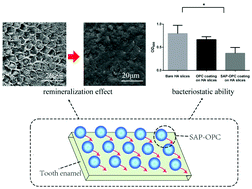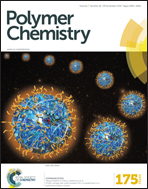Effective in situ repair and bacteriostatic material of tooth enamel based on salivary acquired pellicle inspired oligomeric procyanidins†
Abstract
Remineralization and reduction of cariogenic bacteria at the tooth surface are effective ways to treat dental caries. In this work, a type of in situ repair and bacteriostatic material, i.e., salivary acquired pellicle inspired oligomeric procyanidins (SAP-OPC), was prepared for tooth enamel. Oligomeric procyanidins (OPC), as the active ingredient of grape seed extract, has good remineralization ability and bacteriostatic effects. The peptide sequence DDDEEKC, which has strong adsorption ability on hydroxyapatite (HA), is inspired by the sequence of statherin in the salivary acquired pellicle (SAP). Thus, SAP-OPC has the capability to tightly adsorb on the enamel surface, then repair the tooth decay and inhibit the growth of biofilm of cariogenic bacteria. We mainly explored the relationship between the remineralization property and aggregation morphology of SAP-OPC, and evaluate the anti-bacterial adhesion ability of the SAP-OPC coating. The acid-etched enamel was treated by SAP-OPC and SAP-OPC/Fe(III) and then incubated in artificial saliva. After 2 weeks, the HA mineralized layer was regenerated significantly on the surface of acid-etched enamel samples, and the hardness of the samples recovered to 61.6% and 76.8%, respectively. Also, SAP-OPC exhibited good antibacterial adhesive effects in the bacteriological test. In summary, SAP-OPC has good performance as restorative biomaterials to resist bacteria and also induce the remineralization of tooth enamel.


 Please wait while we load your content...
Please wait while we load your content...